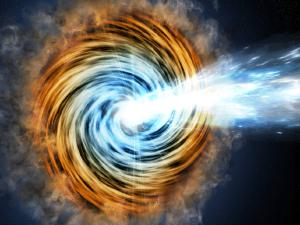Blog
The Blazar
at the End
of the Universe
9 March 2020
 M. Weiss/CfA
M. Weiss/CfABillions of light-years away, immense black holes consume matter at a furious rate. Some of the nearby matter is intensely heated and cast off in jets at nearly the speed of light. When one of these jets happens to be aimed at Earth, we see them as blazars.
We see these cosmic powerhouses throughout the universe, but we aren’t entirely sure when they started to form. If they formed early, then they were likely the kernel around which galaxies formed. If they formed late then they likely appeared within galaxies that already existed.
Recently a team found the most distant blazar ever observed.1 It has a redshift of z ~ 6, which puts its age at about 13 billion years. This means this particular blazar was already active when the universe was less than a billion years old.
We only see blazars when they are pointed in our direction. They are part of a more general group of objects known as active galactic nuclei, or AGNs. These include things like radio galaxies and quasars. Each has a different appearance because of the orientation of the supermassive black hole. Blazars are the brightest AGNs, so at large distances, they are the ones we can most easily see. Since galaxies tend to be oriented in random directions, for every blazar we observe, there are about 100 other AGNs.
In finding such a distant blazar, the team has shown that they likely formed early on. They formed the seeds of supermassive black holes we observe in galaxies today.
Belladitta, S., et al. “The first blazar observed at z > 6.” Astronomy & Astrophysics 635, L7 (2020). ↩︎